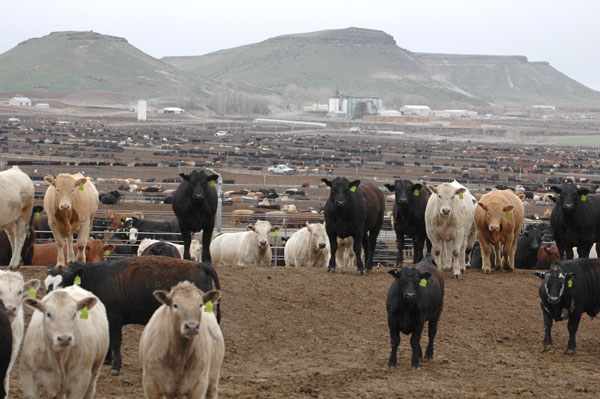A ranch’s reputation for producing quality calves gets around – and can lead to better prices.
February 13, 2020

The better the genetics, the more the profit potential. That’s what Cactus Feeders has learned from historical data on hundreds of thousands of cattle, which allows the feeding company to closely project the value of cattle headed to one of its 10 feedyards.
Justin Gleghorn, Cactus Feeders director of value management at the company’s Amarillo, Texas, headquarters, outlined the benefits of feeding better quality cattle during his presentation to ranchers and stocker operators at the recent Southwest Beef Symposium in Amarillo.
“Cattle with a good brand of genetics usually work better at the feedyard,” he said.
Cactus regularly ships about 20,000 fed cattle per week from its feedyards in Texas and Kansas. Close to one out of every 25 head fed in the U.S. is from a Cactus yard. Its database includes steers and heifers, native cattle, those with a Mexican origin, multiple weights and high- and low-risk animals.
Detailed records enable Cactus to project breakevens for all cattle. “We don’t determine success of an animal by its average daily gain,” Gleghorn said. “We look at what we paid for it and how much we spent for every day it was on feed.
“With our historical data, we can typically put value on cattle and develop a breakeven. From that projection, we can hedge them and determine what we can pay for them.”
David Anderson, Texas A&M AgriLife Extension livestock marketing economist, points out that a ranch’s reputation for producing quality calves gets around – and can lead to better prices. “Feedlots look for cattle that have better feed efficiency in the feedlot,” he said. “Also, calves that don’t get sick are worth more.
“When a cattle feeder knows who produces those calves that are feedlot profitable, there will be demand for that ranch’s calves. That produces premium prices over everyone else.
“Those strong genetics get proven in feeding through repetition. To get those better prices may involve the rancher and feeder getting together to make a deal based on evidence.”
Better calves will also bring better-than-average prices at a market. “But again, information has value and being able to communicate that to buyers has value through premium prices,” Anderson says.
Gleghorn says Cactus works to sort cattle with the better genetics to assess what they can do at different weights. “They usually have better uniformity, which makes it easier to predict how they will perform and grade,” he says. “Cattle that are more plain have more variability and are harder to project.”
Genetic potential has helped cause an increase in hot carcass weight. Carcass weights were about 700 pounds in 1974 compared to about 900 pounds now. “Carcasses are above 70% Choice now, compared to about 35% Choice 20 years ago,” Gleghorn says. “That goes back to more genetic potential.”
Gleghorn said the value of higher-quality cattle was highly illustrated the last half of 2019, when the Choice-Select spread took a wide turn upward from the five-year average.
The spread had been in the $3-$6 range until mid-June, when it was near $20. But while the spread has typically narrowed from June through mid-November, it widened substantially.
It approached $25 by July, compared with about $15 for the norm. By mid-August, it was near $28, compared to about $12 for the five-year average. In mid-October it pushed $29, compared to about $13 for the norm. The spread remained above $20 from mid-June through Dec. 1.
AgriLife Extension notes that there is no way to guarantee cattle will always bring top market prices, but with proper management and marketing procedures, discounts can be prevented.
AgriLife suggests that ranchers produce the kind of calf that is in demand, use management practices that will prevent discounts and spend ample time marketing the calves they worked all year to produce.
“I think it has to start with a herd that is well fitted to its environment and conditions,” Anderson says, “a cowherd that is developed to maximize ranch profits — productive, high weaning rates, low winter feed costs, good weaning weights, etc.
“To realize the value of higher grading cattle, the rancher may have to own those cattle through finishing, or partner in the feeding, while selling on a grid. Cattle with high feed efficiency may not be the same ones that grade the best. There are tradeoffs that require some analysis of what cattle are most profitable at the ranch, feedlot and packer.”
Anderson says there is value to good genetics, “but we ought to think about our production system and what genetic traits are most profitable to select.
“It's a real balancing act across all those different values,” he says. “Part of our problem is that the market signals across all those segments aren’t always very clear.”
Gleghorn stresses that animal health issues are higher with cattle that are not on a vaccination program. “We don’t see a lot of issues with cattle on a good vaccination protocol,” he says, but issues can also unexpectedly hit cattle with better genetics. “We’re seeing more BRD in low-risk cattle and working to find out why.”
Stalcup is a freelance writer based in Amarillo, Texas.
About the Author(s)
You May Also Like



